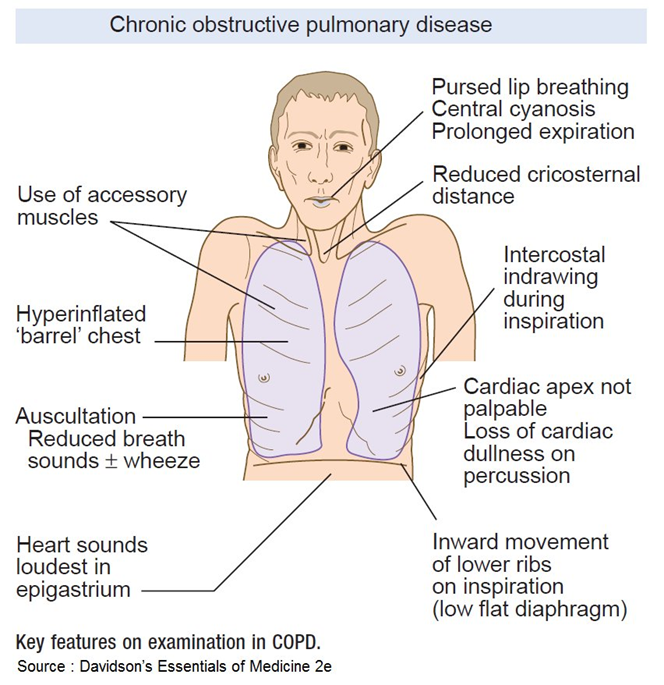A nurse assesses a client’s respiratory status. Which observation indicates that the client is having difficulty breathing?
Diaphragmatic breathing
Controlled breathing
Pursed-lip breathing
Use of accessory muscles
The Correct Answer is D
A. Diaphragmatic breathing:
Diaphragmatic breathing, also known as abdominal or deep breathing, is a normal and effective way of breathing. It involves the contraction and relaxation of the diaphragm, allowing for efficient lung expansion. This is a healthy and efficient breathing technique.
B. Controlled breathing:
Controlled breathing refers to a deliberate and regulated breathing pattern. It can include techniques such as paced breathing, where the individual consciously controls the rate and depth of their breaths. Controlled breathing is generally considered a positive and intentional approach to managing respiratory function.
C. Pursed-lip breathing:
Pursed-lip breathing is a breathing technique where the individual breathes in through the nose and exhales through pursed lips. This method is often taught to individuals with certain respiratory conditions, such as chronic obstructive pulmonary disease (COPD), to help improve lung function and alleviate shortness of breath. Pursed-lip breathing can be a helpful strategy in specific situations.
D. Use of accessory muscles:
The use of accessory muscles indicates that the person is experiencing increased difficulty in breathing. Accessory muscles, such as the neck and shoulder muscles, are not typically heavily involved in breathing under normal circumstances. When these muscles are visibly working during breathing, it suggests increased respiratory effort and can be a sign of respiratory distress or difficulty.
Nursing Test Bank
Naxlex Comprehensive Predictor Exams
Related Questions
Correct Answer is C
Explanation
A. Kyphosis and clubbing of the fingers:
Kyphosis refers to an excessive forward curvature of the spine, which is not directly related to diminished breath sounds. Clubbing of the fingers is often associated with chronic respiratory conditions, but it is not directly linked to the finding of diminished breath sounds.
B. Dyspnea and hypoxemia:
Dyspnea (shortness of breath) and hypoxemia (low oxygen levels in the blood) are common symptoms in COPD, but diminished breath sounds may indicate an additional concern, such as pneumothorax or other complications.
C. Sepsis and pneumothorax:
Diminished breath sounds can be a sign of pneumothorax, a condition where air accumulates in the pleural space, leading to lung collapse. Sepsis is a risk in clients with COPD due to the potential for respiratory infections. Monitoring for these complications is crucial.

D. Bradypnea and pursed-lip breathing:
Bradypnea (slow breathing) and pursed-lip breathing are coping mechanisms that individuals with COPD may use to manage their breathing difficulties. While they are relevant in the context of COPD, they are not directly associated with the finding of diminished breath sounds.
Correct Answer is D
Explanation
A. Lie in a low Fowler’s or supine position:
Lying in a low Fowler's or supine position may worsen respiratory distress and compromise oxygenation. It can reduce lung expansion and increase the work of breathing, especially in patients with pneumonia. This is not a recommended position for individuals with respiratory issues.
B. Increase oral fluids unless contraindicated:
Increasing oral fluids is generally a good practice, especially in respiratory conditions like pneumonia. It helps thin respiratory secretions, making them easier to clear. However, this alone may not address copious tracheobronchial secretions. Suctioning may be needed to effectively remove excess secretions.
C. Increase activity:
Increasing activity may be beneficial for some patients, but it might exacerbate respiratory distress in others, especially if they are already experiencing increased work of breathing. The appropriateness of increasing activity depends on the specific condition and the patient's overall stability.
D. Call the nurse for oral suctioning as needed:
This is the most appropriate choice. If the client is experiencing increased work of breathing due to copious tracheobronchial secretions, calling the nurse for oral suctioning is an intervention aimed at maintaining a clear airway and alleviating respiratory distress. Regular suctioning may be necessary to assist the client in managing secretions effectively.
Whether you are a student looking to ace your exams or a practicing nurse seeking to enhance your expertise , our nursing education contents will empower you with the confidence and competence to make a difference in the lives of patients and become a respected leader in the healthcare field.
Visit Naxlex, invest in your future and unlock endless possibilities with our unparalleled nursing education contents today
Report Wrong Answer on the Current Question
Do you disagree with the answer? If yes, what is your expected answer? Explain.
Kindly be descriptive with the issue you are facing.
